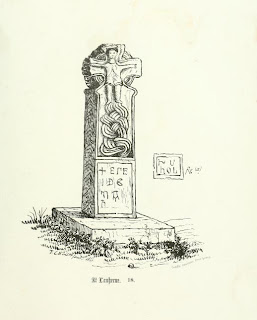Other sources about the Roseworthy cross:

http://www.archive.org/details/specimensofancie00lond
'Specimens of ancient Cornish crosses, wells, fonts etc'
At Lanherne. This remarkable Cross was brought, several
years ago, from the Chapel Close of the Barton of
Roseworthy, in Gwinear, and erected in its present
position. The upper part,which is much mutilated,
represents Christ crucified ; His feet resting on
a support which has the appearance of a
long twisted braid. In the panel below,
and on the reverse side,
are curious inscriptions, both of which are represented
in the plate. (PI. xviii, fig. a).
The proportions of the cross are slightly out...
the braid should be taller.
About Thorpe Salvin.
Roman foundation, with a church with a Saxon
doorway and in the Treasure Report 2000
a mid Ninth century silver find.
see below)
Thoughts: the date of about 850AD ties in
with the 9th century date
proposed for the Roseworthy cross.
It IS unlikely to be original, but
to have contemporary Saxon finds is interesting.
Thorpe Salvin, South Yorkshire: Fragment from
an Anglo-Saxon silver fitting (M&ME 409)
Date: 9th century
Finder: Mr James Rickett
Date of discovery: 1996
Circumstances of discovery: While searching with a
metal-detector.
Description: Silver niello-inlaid fragmentary fitting,
originally consisting of two arching ribs (one now lost),
each terminating in a stylized animal head with rounded
ears and blue glass settings for eyes; the ribs branch off
above a similar animal head, and at the point of
convergence, there is a small rivet hole, surmounted by
a stylized leaf. The animal heads are inlaid with niello
contours on brow and muzzle, and the ribs, which form
their necks, are also inlaid with beaded niello decoration.
Concealed behind the stylized leaf and the muzzle of the
central animal head are two delicate vertically pierced
lugs, one above and one below the rivet hole. The back
is otherwise undecorated.
Stylistically, this elegant fitting relates to mid-9th
century artefacts; the carefully delineated animal heads
with their nielloed detail and blue glass eyes have many
close parallels among the terminals of strap-ends of this
period, on the Strickland brooch and on the Dunwich
seal-die. However, the piece has no functional parallel
and its purpose is uncertain. The lugs at first sight look
as if they might have accommodated a slender rod or
attachment pin, but this would possibly have been fouled
by the protruding end of whatever passed through the
rivet hole, probably the shank of a small decorative boss
of some kind. Alternatively, the lugs might have been
endstops for linking elements. The high quality and
careful execution of the piece suggest that it is likely to
have come from an object of some status.
Dimensions: Length: 24.5mm; width: 16mm; weight:
3.812g.
Disposition: Rotherham Museum hopes to acquire
this find.

